Evaluation of various aspects of four companies operating in New Zealand
Info: 7787 words (31 pages) Dissertation
Published: 9th Dec 2019
Introduction
This report consists of two parts: Part 1 is individual organizational overviews of a designated organization; Part 2 is the analysis of implications for organizational managers. In Part 1, we analyze four organizations by four students: Kathmandu Holdings Ltd, by Yuen Sum Lo; Novotel & Ibies Group Hotel, by Haoyuan Zhao; Kono NZ LP, by Zheng Li; Vodafone New Zealand by Shiva. We discuss about organizational purposes, life cycles, contemporary influences, the resourced based views, cultural paradigms and internal cultures. In Part 2, we compare four organizations and address their similarities and differences in terms of 7S models and cultural paradigms. In the last part, we investigate different organizational attitudes, skills and behaviors that a manager should has to become a successful and efficient leader of top management.Part 1: Individual Organizational Overviews
This section includes four students’ individual reports. Students and designated organizations are: Yuen Sum Lo, Kathmandu Holdings Ltd; Haoyuan Zhao, Novotel & Ibies Group Hotel; Zheng Li, Kono NZ LP; Shiva Raj Sharma, Vodafone New Zealand.Kathmandu Holdings Ltd, by Yuen Sum Lo
Introduction
Established in Christchurch in 1987 (Kathmandu, 2017), Kathmandu Holdings Limited is a New Zealand based company and a market leading retailer of travel and adventure outdoor clothing and equipment. According to (Kathmandu, 2017), it has 1955 employees and 163 stores across New Zealand and Australia. Although the main operations are in the Southern Hemisphere, its manufacturers are located in China, Vietnam and Taiwan. Kathmandu also imports materials sourcing and corporate with community partnerships from every part of the world including Antarctica (Kathmandu, 2017). The organizational structure is a traditional hierarchy as Firgure 1 shows (Kathmandu, 2017).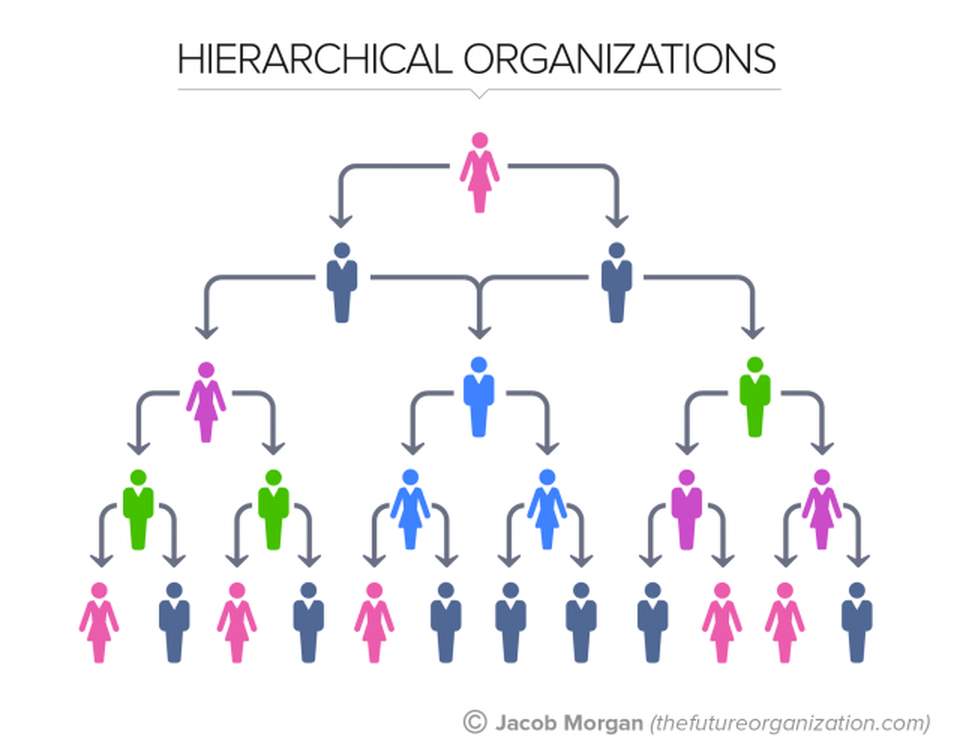 Figure 1 (Morgan, 2015)
Figure 1 (Morgan, 2015)
Organizational Purpose
Organizational purpose establishes a systemic process typically focuses on products, services and customers (Sheila Margolis, 2018). The external inputs are raw materials from suppliers, manufacture production from Asia countries, global transportation, partnerships with industry associations. The internal conversion of Kathmandu is a transformation process which transfers inputs into goods and services for customers. This stage usually happens inside the organization and controlled by managers (Seth, 2017). It requires management skills to control purchasing, transporting materials, monitoring product quality, recycling internal wastes and used clothing, and all employee efforts. The external outputs are outdoor garments and equipment, contribution to environment in terms of wastes and carbon emission, contribution to charities like Red Cross, creating job opportunities in different regions, profits and dividends to shareholders (Kathmandu, 2017).Organizational Life Cycle
The current life cycle of Kathmandu is maturity as it produces stable net profit annually. The management is likely to be pleased with the status as the CEO and CFO remain the same people. Figure 2 represents the life cycle of an organization.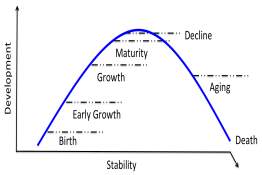 Figure 2 (Seth, 2017)
Figure 2 (Seth, 2017)
Contemporary Influences
There are a number of factors influencing Kathmandu’ behavior. We can investigate the organizational behavior by analyzing two of the PESTEL elements. Social element: The leisure interests of population can affect the demand. Also, the willingness and motivation to choose Kathmandu rather than other outdoor brands are affected. The social element represents a negative effect on Kathmandu: limitation on population’s leisure interests. In reality, only New Zealanders and Australians enjoy outdoor adventures, so the demand is still small. This explains why Kathmandu only operates stores in these 2 countries. Technological: In the era of sustainability, “greens” technology for recycling wastes, used materials and put into garment production is acquired and staffs should be skillful. This represents a positive effect. With “green” technology, it successfully depicts Kathmandu as eco-friendly organization and controls as less as possible damage to the environment. The Force of Globalization: Supply sources are critical to Kathmandu because it is not always easy to obtain “green” materials. The company prefers to balance between fair trade and global competition as it purchases raw materials from minority communities (Kathmandu, 2017). Although it fosters the local economies, these minor communities face tremendous competition in global supply sources market and may not capable to stabilize the costs of supplying the materials. This could lead to managerial difficulty and profit decline.The Resource Based View
A resource-based view is used to determine whether the organization is capable to deliver comparative advantages over its competitors (Wikipedia, 2018). It measures organizational progress regularly (Seth, 2017). In Kathmandu, it keeps expanding partnerships with 14 industrial associations. This is a big help for organizational progress and developing strategic solutions to challenges in garment industry (Kathmandu, 2017). Another resource-based view for Kathmandu is sophisticated fabric technology. In 1994, Kathmandu launched “Ecofleece” which was a recycled fleece fabric (Kathmandu, 2017). Nowadays, it still recycles and transform used materials, such as polyesters and plastic bottles, into production every year. In 2017, Kathmandu recycled 4 million bottles into products (Kathmandu, 2017).The Cultural Paradigm
The most obvious indicators of Kathmandu’s cultural paradigm are organizational structure, internal process and story. First, the organizational structure is hierarchy that clearly defines each Chief Officer’s job responsibilities and authorities. Second, Kathmandu internal process is mainly outsourced. Most of the material supply sources, manufacturers, partnerships and employee efforts obtained outside New Zealand. Third, the story of Kathmandu remains green and eco-friendly as an organizational heritage.The Internal Culture
The internal culture mostly applicable to Kathmandu is adhocracy. First, the internal-external focus of attention is the company’s external focus on how to sustain organizational growth and environment. To the extent of reducing damages to the environment, emissions of wastes during production and collecting sustainable materials are essential to decision-making. It supports innovativeness, eco-friendly visions and finding new resources. Second, the organizational structure is stable and flexible at the same time because it has various community partnerships from the globe. Advices and coaching from industrial associations will be taken into organizational operations (Kathmandu, 2017). Third, the control processes are delegated to suppliers and manufacturers and inspected by company’s audit teams. Kathmandu has over 140 suppliers outside New Zealand which requires sophisticated audit teams to ensure product quality and labour performance (Kathmandu, 2017)Novotel & Ibies Group Hotel, by Haoyuan Zhao
Introduction
Novotel is one of the members of AccorHotel. The first Novotel was opened at 1967 by Paul Dubrule and Gérard Pélisson in France (accorhotel 2001). There are 9 Novotel & Ibis hotels located in New Zealand and two of these are in Auckland, one is at Ellerslie and another one is at Auckland International Airport. According to the statistics, there are about 300 employees hired in each Novotel Hotel around the world. (Novotel & Ibis, 2011). As one of the luxury brand of AccorHotel, Novotel & Ibis always follow two core primary activity. They make two strategic divisions since the end of 2013 in order to ensure long term expansion: Hotel Service, that include the operator and franchiser, and Hotel lnvest, that include the owner and investor. The first part, that is the 4100 Hotel and 570,000 operating which under the AccorHotel brand, their need to manage all of the operation and provide the best choice of service for partner owner, achieve the values and resource shared. And the second part what the owner and investor, they need to simplify and manage existing portfolios through three standard asset disposals and acquisitions: margin, cash generation and location (Accorhotel). The structure of an organization is mainly a hierarchical concept. In the early 1990s, the top managers of AccorGroup realized that company was in a transitional state, they have to make a new project to catch this stage. The new project is preparing to reduce the costs and install the new work practices to take advantage from competitors. As picture shown below is current management structure of Novotel. In addition, top manager has authority for choosing team member, it is a typical geographical organization (UKEssays 2015).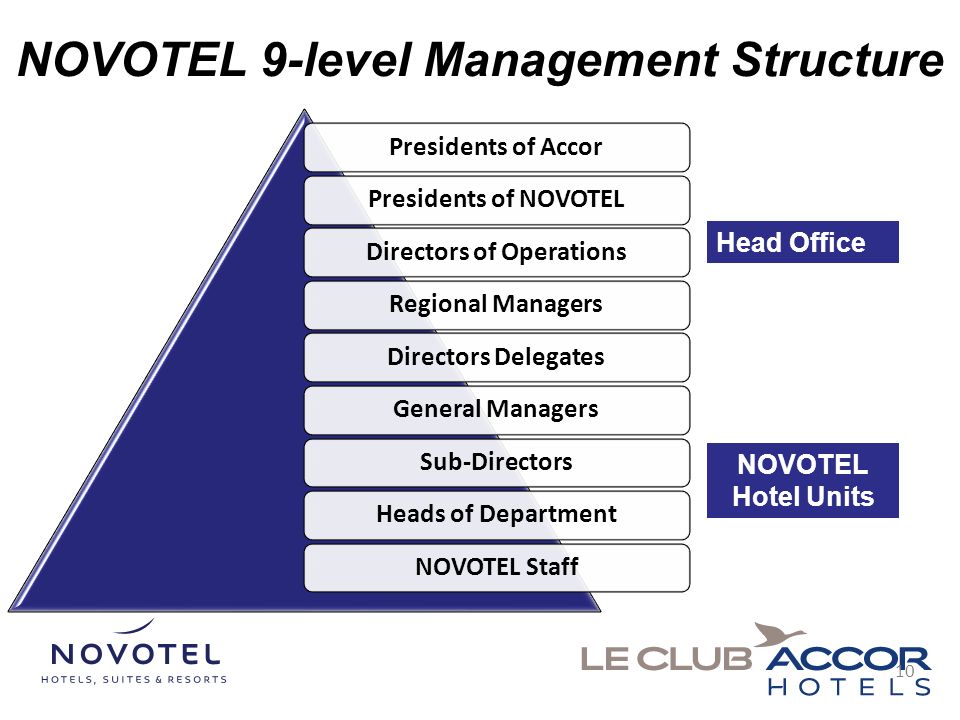
Organizational Purpose.
Common areas were redesigned, new food and beverage offers were created, and new consumer technologies were used. Have 1500 economy hotels on four continents, all economy brands of Accor must be unified with the purpose of profit and global development. With this new brand strategy, Accor`s purpose was reinforcing their economy brand, increase customer satisfaction, utilize the distribution-loyalty systems efficiently and grow globally by using these brands (HNN Newswire, 2011). The External Input of Novotel is they would get the difference style of F&B and decoration from local supplier in order to adapt local custom. It`s internal conversation is as a hospitality industry, they would transit the best service and accommodation experience for customer to keeping their customer loyalty. Also external output is attraction of outside tourism and increase local income of tourist trade.Organizational Life Cycle
AccorHotel Group and Novotel & Ibies hotel`s life cycle is current maturity. Whole business running has already format an integrated system. This system available for most of firm which under the Accor Group even any new brand is created, only need to do small change depend on the specific condition.Contemporary Influences.
Public sector increase revenue and taxation by easier controlling of large hospitality industry. The increase of hospitality industry also influences local`s societal. Tourism attract more and more people come to the place to bring abundant of resource, that would promote the development of local infrastructure.The Resource-Based View
The most noteworthy capabilities of the two directors are their radical response to the threats that companies face, the ability to effectively allow internal consultation processes among employees, and the rapidity of sales and implementation of change plans in other hotel (UKEssays 2015).The Cultural Paradigm
Every brand of hotel has their own organizational culture, so Novotel is. Novotel & Ibies is one of the luxury brand in Accor Group, it has their own group cultural paradigm, that is story and symbol. Paul Dubrule and Gérard Pélisson opened the first Novotel in 1960s. Today, it is become to AccorsHotel around the world. In the Novotel & Ibies, it is always said that they are not talking about the employee, they are talking about talents, they always try to recognize each person`s value, and make it to their promise. They bring their talent to the group and to make them a proactive part of their own development.The Internal Culture
Novotel & Ibies Hotels group has a strict structure system, so it pertains to Hierarchy Internal Culture. There 250,000 talents people hired by AccorHotels and more 300 employees in each firm, so every department has their own department structure, from the bottom to up, everyone has to be report their inquire to each manager or supervisor in order to get acceptation. Because everyone has their own duty and responsibility, only the right person can figure out the right inquire.KONO NZ LP, BY ZHENG LI
Introduction
Kono NZ LP is a Maori owned company which was established in Nelson in 2011 (Wakatū Incorporation, 2015). It deals in seafood, wine, fruits, fruit processing products and fisheries with more than 400 employees (Wakatū Incorporation, 2018). Kono is a subsidiary of Wakatu Incorporation, a famous Maori company with a history of more than 40 years (Wakatū Incorporation, 2015). The organizational structure of Kono is likely to be this graph (Kono, 2015):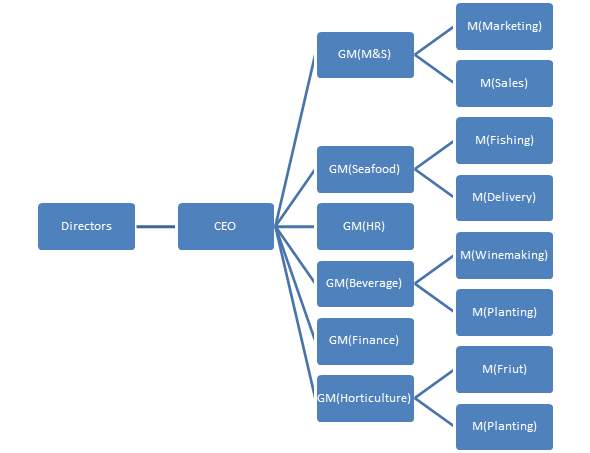
Organizational Purpose
External Input: 530 hectares of land and oceans, and more than 400 employees (Wakatū Incorporation, 2018). Internal Conversion: Plant, produce, sell and transport services (Kono, 2015).External Output: Customs, job opportunities, profits (Kono, 2015).Organizational Life Cycle
The company should be at a growth stage in the organizational life cycle. As I mentioned before it was founded in 2011, and then acquired Tohu (Kono, 2015), an award-winning wine brand (Tohu wines, 2018), and Yellow Brick Road which is leading the way in the industry by quickly placing orders online (Yellow Brick Road, 2013). We foresee that these high-quality subsidiaries will bring great wealth to the parent company, Kono, in the next five to 10 years. Therefore, we believe that Kono will have a certain stage of growth in the future.Contemporary Influences
Political influence: It is obvious that Kono benefit from TTe Ture Whenua Maori Act 1993 and the Maori Reserved Land Act 1955 (plus amendments), and no exception (Wakatū Incorporation, 2015). Only after these laws were passed did Kono's founders have access to a vast amount of high-quality land and sea areas, thus creating Kono. Technological influence: Kono has a close partnership with Callaghan Innovation to provide the company with a number of up-to-date research projects that have a positive impact on Kono's continuous progress (Wakatū Incorporation, 2015). The impact of globalization: The increasingly globalized business is a great challenge for many companies (Colapinto, 2013), but a good opportunity for Kono . Kono has a rich product resource, with excellent quality, and the influence of globalization has caused the products of Kono to be exported to 25 countries and regions (Kono, 2015). Especially in the Asian market with a large population, globalization has brought positive and far-reaching effects to Kono (Alden, Steenkamp & Batra, 2006). The Resource Based View This part will analyze the matching relationship between the resources, internal structure and the ability to meet the challenges of market (Szymaniec-Mlicka, 2014). Advantageous resources:- Land and ocean resources: This enterprise has vast quantities of good land and ocean resources, and these resources are not easily obtained by any other organization. This indicates the scarcity of the market competitive resources of Kono.
- Strong financial resources: Kono's parent Wakatu incorporation well-funded. This is also a rare advantage.
- Special cultural resources: Maori culture is similar to Asian culture, and Asians have a natural affinity for Maori culture. Therefore, in the competition of Asian market, Maori will highlight its cultural advantage to gain more Asian market share.
The Cultural Paradigm
Kono, a Maori company, also seems to conform to the story and symbols of organizational culture paradigm (Harmsworth, 2005). For example, on the home page of their company's website, they highlight the history of the founder of the company and emphasize the cultural values of the Maori people.The Internal Culture
It seems that the clan is the internal organizational culture of the company. Teamwork, people-oriented, recognition and respect for everyone's talents are the values of this company. Moreover, employees can have multiple flexible movements within the enterprise (Kono, 2015), which also indicates that Kono's internal culture is mainly based on the value needs of employees (Smith, Peters & Caldwell, 2016). Therefore, we believe that its internal organizational culture is the clan type.Maori Principles and Values
Through the case analysis of Kono company, we can see the following principles and values of this Maori company: 1. Principles combine cultural and commercial aspects (Harmsworth, 2005) 2. Value the continuity of the enterprise. Their goal is to build a business that will last 500 years (Kono, 2015) 3. With the development and progress of society, they began to pay attention to education (Wakatū Incorporation, 2015) and the cultivation of future generations (Harmsworth, 2005) 4. There is a need to balance competing cultures, societies, businesses and the environment (Harmsworth, 2005)VODAFONE NEW ZEALAND, by Shiva Raj Sharma
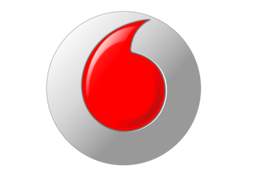
INTRODUCTION
The internet, mobile telephony, mobile data, broadband internet, satellite communications, digital television & radio, various internet-based business etc. has all surrounded us and it seems impossible that businesses & life today is possible without these services. Among few global leaders with international operations, Vodafone is one of the world’s largest telecommunication service provider. Vodafone NZ was first established here in the year 1998 after purchasing BellSouth’s operation in New Zealand making it New Zealand’s largest mobile phone operator. Parent Vodafone company is a London based Public Limited Company (PLC) and Vodafone New Zealand is its subsidiary (Wikipedia, 2018).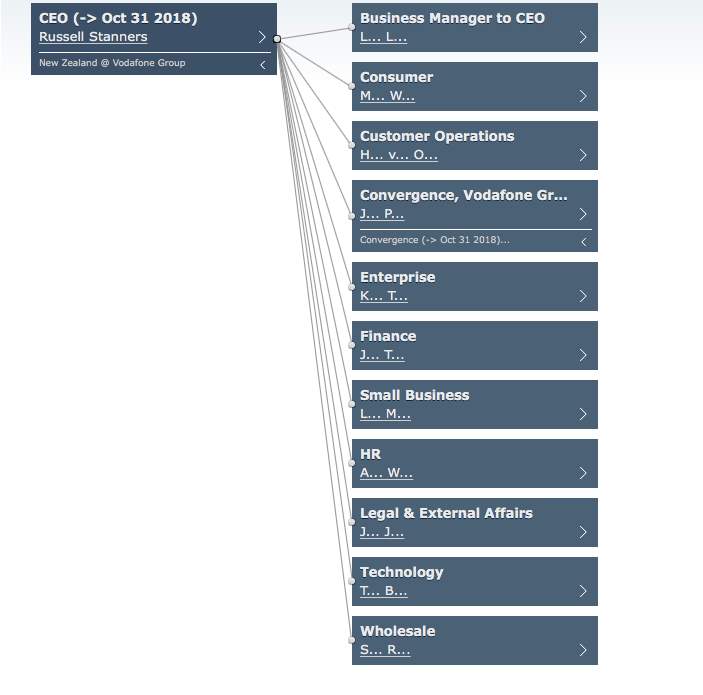 Organizational structure of Vodafone New Zealand is a hierarchical one with each individual staff reports to their immediate superiors.
Organizational structure of Vodafone New Zealand is a hierarchical one with each individual staff reports to their immediate superiors.
Organizational Purpose
Vodafone New Zealand being a telecom provider basically serves a purpose to generate revenue selling products designed to meet requirements of millions of customers. Vodafone New Zealand has its main internal inputs as manpower, infrastructure, interconnected mobile network (4G & 5G), fixed line and internet service. With a proven and successful business plan and sophisticated system in place it utilizes infrastructure, manpower and technical assets to generate profit for its shareholders. Vodafone NZ has also been giving out back to the society as part of their corporate social responsibility (Wikipedia, 2018).Organizational Life Cycle
At the launching in 1998 it had just 138,000 customers which roughly would be one in 30 New Zealanders with a limited coverage area. With other competitive service providers in the market and constantly evolving market of telecommunication it would be safe to assume that Vodafone New Zealand is in growing stage of its organizational life cycle.Contemporary Influences
Like any other multinational company Vodafone New Zealand’s behavior is highly influenced by number of factors which can be investigated by analyzing the 3 of the PESTEL elements. Social Element: Vodafone New Zealand is highly affected by the social factors like the population of any given coverage area, their profession and need to use its services, age group of people and their expense habit. Vodafone New Zealand would have significant social influence as the people using and spending on their services will fluctuate with factors like festivities, natural calamities, and different time in days of a week as well. Technological Element: Vodafone New Zealand has a great technological influence that has helped it acquire new market and customers with its fast-paced service evolution. Today Vodafone is thriving as more people use their services as they offer better technology in cheaper rates. Vodafone currently has 1560 cell sites that covers 98.5 % of area where major population lives. They have 72 Vodafone shops in the country from where they offer their services (Wikipedia, 2018). It is safe to assume that technological element has always been a strong hand for this company as they are quick to adapt and offer the latest in competitive rates compared to other operators in the country (Vodafone NZ, 2018). The Force of Globalization: Vodafone being a Multinational Company that has operations in over 27 countries including New Zealand. Vodafone New Zealand acquires the hardware and equipment’s from all around the world specially China, USA and Europe. It also outsources customer care and software R&D to countries like India and China (Vodafone NZ, 2018).The Resource based View
Vodafone New Zealand’s capabilities to stand out and beat its competition and deliver strong global presence and its ability to adapt and offer latest technology in the market at lower cost is to name one. Best quality call, High speed broadband, fixed line phone, broadband television is considered better and preferred by millions of New Zealanders today. It has helped gain Vodafone New Zealand the largest market share as well.The Cultural Paradigm
The most notable cultural paradigm of Vodafone New Zealand is its obsession for the customers and an ambitious team that offers new products and services in the market first. This company is innovation hungry as they were the first to offer various services & products. Vodafone New Zealand has a culture to lead the market and bring the best innovation, network experience and value to their customers.The Internal Culture
Vodafone NZ has a thriving internal culture that offers flexibility and growth to its employees. It seems to respect individuality and thus has smart causal as dress code. However, retail staffs are provided with snappy uniforms that represents Vodafone (Vodafone NZ, 2018). Work hours has flexibility too as one can work in shifts, part-time, remote working, condensed hours depending on the role.Part 2: Implications for Organizational Managers
Introduction
In Part 2, we will compare the similarities and differences between all four organizations in terms of 7S models, cultural paradigms, organizational attitudes, skills and behaviors. It will be presented in the form of a table, with the corresponding explanation. There are six sections in Part 2:- Similarities and differences between organizational 7S Model
- Similarities and differences between organizational cultural paradigms
- Attitudes and values for an organizational manager
- Skills for an organizational manager
- Behavior for an organizational manager
- Conclusion of this report
The 7S Model
 Figure 3 (Seth, 2017)
In terms of 7S Models, there are similarities and difference between all four organizational profiles.
Figure 3 (Seth, 2017)
In terms of 7S Models, there are similarities and difference between all four organizational profiles.
| Kathmandu | Novotel | Vodafone New Zealand | Kono NZ LP | |
Similarities
|
|
|
|
|
Differences
|
|
|
|
|
The Cultural Paradigm
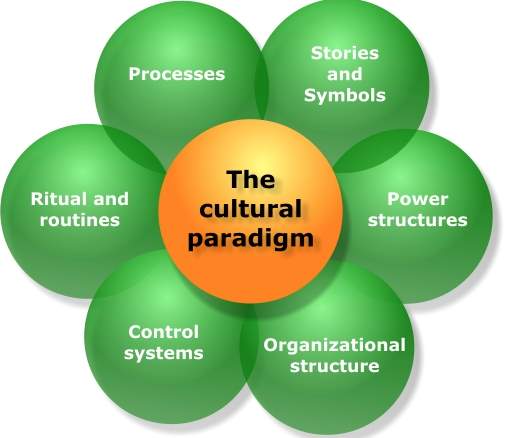 Figure 4 (Seth, 2017)
In terms of cultural paradigm, there are similarities and difference between all four organizational profiles.
Figure 4 (Seth, 2017)
In terms of cultural paradigm, there are similarities and difference between all four organizational profiles.
| Kathmandu | Novotel | Vodafone New Zealand | Kono NZ LP | |
Similarities
|
|
|
|
|
Differences
|
|
|
|
|
Maori Principles and Values
As we mentioned before, through the case study of Kono company we can see the Maori organizations' principles and values usually combine their cultural and commercial aspects (Harmsworth, 2005). They value the sustainability of the organization and the needs of community (Warriner, 2009). In this case, we recommend that if the Maori companies can conform the processes cultural paradigm, such as Kathmandu and Novotel, their productivity of the companies will be more efficient.Attitudes
The organizational attitude is a deeply held belief, originating from company’s own characteristics, upbringing, influence in the industry which determines what is right or wrong, achievable or unachievable (Seth, 2017). With the previous discussion of similarities and differences, there are some values and attitudes that would be most commonly expected of an organizational manager.| Values and Attitudes | |
| Kathmandu | Managers should be honest and integrity, open mind to adapt changes, passion of what he does and protect the environment. |
| Novotel | Manager has to be a sharp-sighted people to adapt in finding the change of market, also |
| Vodafone New Zealand | One should not only be positive, empathetic and decisive, but also accountable, honest and have patience. Good at excavate a good talent people of organization. |
| Kono NZ LP | Put people first, take responsibility for yourself and do the best you can. The value gives the managers a positive attitude. |
Skills
With the previous discussion of similarities and differences, there are some skills that would be most commonly expected of an organizational manager.| Kathmandu | Novotel | Vodafone New Zealand | Kono NZ LP | |
| Conceptual Skills | Organizational decisions should be made based on “sustainability” | Take customer satisfaction as the first priority and be good at responding to constantly changing situations. | Create better and cheaper products and keep consumers at the core. | As the same as Kathmandu, decisions made based on " sustainability with profits" |
| Human Skills | Be open mind and thoughtful to outdoor industrial partners and other staffs | Good communication ability in order to solve any requiring or complain. | Develop public relations and communication skills. | Respecting all the members in the "big family", and believe everyone can achieve in their area of expertise |
| Technical Skills | Be good at auditing manufactural process | Known well the basic acknowledge of the department which he in charge and consciousness of self-improvement. | Understand the evolving global technology and stay updated. | Communication, independent thinking and execution ability |
| Analytical Skills | Be able to explain and present eco-friendly ideas to industrial partners and other stakeholders | Be good at finding the main point from the report every week or month in order to make new strategy with current situation. | Be thoughtful and responsive to customer's changing needs. | Be able to see through the appearance to perceive the essence |
| Diagnostical Skills | Be sensitive to spot the problem and find out proper solution during garment supply chain | Easy to find primary cause of any problem from customer and to resolve it well. | Should be able to resolve issues within the team or with client efficiently. | Be able to guide solutions, and deal with more advanced problems |
Behaviors
With the previous discussion of similarities and differences, there are some behaviours that would be most commonly expected of an organizational top-level manager.| Kathmandu | Novotel | Vodafone New Zealand | Kono NZ LP | |
| Planning | Based on sustainability, plans should be compatible with environment and social responsibility | Improve service quality constantly, maintain and reinforce the customer loyalty. | Stay updated with the latest technology and trend to plan product and services accordingly. | Planning based on law requirement regarding seafood and to be programmatic |
| Leading | Before leading the staffs, the manager should be self-oriented to do the job first | Finding a feasible and useful and right way to lead stuff to improve department performance. | Lead by example and demonstrate willingness to help and support. | Proactive in the industry, making the right decisions about the company's development in future. |
| Organizing | Assign job duties to manufacturers teams and set up requirements for each task | Become a core of organization and be a spiritual pillar in the department. | Plan ahead to offer best services and products to maintain the first in the market status. | Scheduling suppliers and arranging transportation |
| Controlling | Control and monitor manufacturers performance regularly | Friendly and strictly management with an opportune monitor | Control the quality of service provided in terms sales and after sales services. | Monitor products and staff performance quality |
Conclusion
In this report, our group chose four difference organization that including retail industry, hospitality industry, food processing industry, electronics industries and analyze some parts of difference and similar business and leadership. After collected all the details of the four organizations which we choice, we have got a result that main management mode of each domain. The top manager not only has to be possess the basic management capacity, but also need to have some specific capability which ordinary stuff doesn`t have. That would contribute to us to understand core competitiveness and organizational culture of each domain. Thereby understand more capability of management in various of industry.Bibliography
Kathmandu. (2017). Sustainability Report 2017. Retrieved from Kathmandu: https://issuu.com/kathmandulimited/docs/kathmandu_sr_2017_development12_lr?e=31218367/54227240 Morgan, J. (2015, Jul 6). The 5 Types Of Organizational Structures: Part 1, The Hierarchy. Retrieved from Forbes: https://www.forbes.com/sites/jacobmorgan/2015/07/06/the-5-types-of-organizational-structures-part-1-the-hierarchy/#c34ac0b52529 Sheila Margolis. (2018). What is an organization’s Purpose? Retrieved from Sheila Margolis: https://sheilamargolis.com/core-culture-and-five-ps/the-five-ps-and-organizational-alignment/purpose/ Seth, N. (2017, April 20). Lecture Slides of Capabilities for Managers Session 3. Wikipedia. (2018, May). Resource-based view. Retrieved from Wikipedia: https://en.wikipedia.org/wiki/Resource-based_view Kathmandu. (2014). Kathmandu Annual Report 2014. Retrieved from Kathmandu: http://www.annualreports.com/HostedData/AnnualReportArchive/K/ASX_KMD_2014.pdf Wikipedia. (2018). Vodafone New Zealand. Retrieved from Wikipedia: https://en.wikipedia.org/wiki/Vodafone_New_Zealand Vodafone NZ. (2018). Corporate Responsibility. Retrieved from Vodafne NZ: https://www.vodafone.co.nz/our-company/corporate-responsibility/ Statistics Novotel & Ibis Hotel. (2011). Retrieved form https://en.wikipedia.org/wiki/Novotel. AccorHotel What are our two core business activities ? Andriotis, K. (2002). "Sacle of Hospitality Firms and Local Economic Development. The Case of Crete. Tourism Management, 23(4): 333-341 UKEssays (2015). "Looking at the worldwide Novotel Hotel Chain." Essays, UK. (November 2013). Looking at the worldwide Novotel Hotel Chain. Retrieved from https://www.ukessays.com/essays/business/looking-at-the-worldwide-novotel-hotel-chain-business-essay.php?vref=1 Dev, C. S., & Withiam, G. (2012). Branding hospitality: Challenges, opportunities and best practices [Electronic article]. Cornell Hospitality Roundtable Proceedings, 4(5), 6-14. Olsen, M. D., Yeasun, C., Graf, N., Kyuho, L., & Madanoglu, M. (2005). Branding: Myth and reality in the hotel industry. Journal of Retail & Leisure Property, 4(2), 146-162 HNN Newswire. (2011, September 13). Accor restructures international economy brands. Retrieved Apr 5, 2016 from HotelNewsNow: http://www.hotelnewsnow.com/Article/6410/Accor-restructures-economy-brands Smith, S. S., Peters, R., & Caldwell, C. (2016). Creating a culture of engagement – insights for application. Business and Management Research, 5(2), 70-80. http://dx.doi.org/10.5430/bmr.v5n2p70 Colapinto, R. (2013, 11). It's a global village. CAmagazine, 20-25. Kono. (2015). Annies Natural Fruit Bars. Retrieved 06 22, 2018, from kono-nz.squarespace.com: https://kono-nz.squarespace.com/annies-1#annies-natural-fruit-bars Kono. (2015). Our business. Retrieved 06 22, 2018, from kono-nz.squarespace.com: https://kono-nz.squarespace.com/about/#our-business Kono. (2015). Our people. Retrieved 06 22, 2016, from www.kono.co.nz: https://www.kono.co.nz/our-people-1 Kono. (2015). VISION & PURPOSE. Retrieved 06 22, 2016, from kono-nz.squarespace.com: https://kono-nz.squarespace.com/our-story/#vision-and-purpose1 Kono. (2015). WAI INU. Retrieved 06 22, 2018, from kono-nz.squarespace.com: https://kono-nz.squarespace.com/beverages-2#wai-inu Kono. (2015). YELLOW BRICK ROAD. Retrieved 06 22, 2018, from kono-nz.squarespace.com: https://kono-nz.squarespace.com/yellow-brick-road-2#yellow-brick-road-1 Szymaniec-Mlicka, K. (2014). Resource-based view in strategic management of public organizations – a review of the literature. Management, 18(2), 19-30. Doi:10.2478/manment-2014-0039 Tohu wines. (2018). Awards. Retrieved 06 22, 2018, from www.tohuwines.co.nz: https://www.tohuwines.co.nz/pages/awards Wakatū Incorporation. (2015, none none). A business of the land and sea. Retrieved 06 22, 2016, from www.wakatu.org: https://www.wakatu.org/#welcome Wakatū Incorporation. (2015). Development & Innovation. Retrieved 06 22, 2018, from www.wakatu.org: https://www.wakatu.org/development-innovation-1 Wakatū Incorporation. (2015). Growth of Wakatū Group. Retrieved 06 22, 2016, from www.wakatu.org: https://www.wakatu.org/growth-of-wakatu-group Wakatū Incorporation. (2015). History of Land. Retrieved 06 22, 2018, from www.wakatu.org: https://www.wakatu.org/history-of-land Wakatū Incorporation. (2018, 05 05). Recognition for Kono CEO Rachel Taulelei at Māori Business Leaders Awards. Retrieved 06 22, 2018, from www.wakatu.org: https://www.wakatu.org/news-stories/2018/5/5/recognition-for-kono-ceo-rachel-taulelei-at-mori-business-leaders-awards Yellow Brick Road. (2013). Yellow Brick Road. Retrieved 06 22, 2018, from www.yellowbkroad.com: http://www.yellowbkroad.com/ Warriner, V. C. A. (2009). Internationalisation of Maori businesses in the creative industry sector: ko te rerenga o te toki a tu, he whare oranga: a thesis presented in partial fulfilment of the requirements for the degree of Doctor of Philosophy in Management at Massey University, Albany, New Zealand. http://hdl.handle.net/10179/1244 Alden, D. L., Steenkamp, J. B. E., & Batra, R. (2006). Consumer attitudes toward marketplace globalization: Structure, antecedents and consequences. International Journal of Research in Marketing, 23(3), 227-239. https://doi.org/10.1016/j.ijresmar.2006.01.010 Ashton, K. (2009). That ‘internet of things’ thing. RFID journal, 22(7), 97-114. Butler, S. (2006). New Zealand-Culture Smart! : The Essential Guide to Customs & Culture: Bravo Limited. https://www.vodafone.co.nz/our-company/corporate-responsibility/Cite This Work
To export a reference to this article please select a referencing stye below:
Related Services
View allRelated Content
All TagsContent relating to: "Business Analysis"
Business Analysis is a research discipline that looks to identify business needs and recommend solutions to problems within a business. Providing solutions to identified problems enables change management and may include changes to things such as systems, process, organisational structure etc.
Related Articles
DMCA / Removal Request
If you are the original writer of this dissertation and no longer wish to have your work published on the UKDiss.com website then please:




